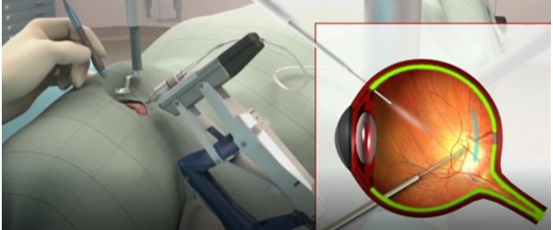By Gary Elinoff, contributing writer
Advances in AI and robotics will make what was previously impossible possible, and they’re already helping cash-strapped systems save time and money. Let’s take a look at some present-day examples and see what may be in store for the future.
Will robots replace human surgeons?
Because AI that can deal with the myriad of variables involved in performing surgery does not yet exist, robots are not ready to replace human surgeons. For the foreseeable future, surgeries will be directed by the human mind, but there are limitations to what the human hand, however skilled, can do.
In eye surgeries that involve the retina, for example, there are levels of precision required that are at or beyond human capabilities. The very blood coursing through a surgeon’s arteries as his or her heart beats causes tiny hand tremors that put the chances of a good outcome at risk.
Newer, bolder surgeries that are now being planned would be impossible without surgical robots like the Preceyes developed by an Eindhoven University of Technology spinoff. As reported by the BBC, robotic systems will make possible more advanced retinal gene therapy, which will involve injecting actual stem cells directly into a very precise location on the retina.

Robotic eye surgery. Image Source: BBC.
Robotic triage
Have you ever noticed that on your health insurance membership card, there is a dial-a-nurse option? You can call this number to get some solid medical advice or to see if you actually need to see a physician. A good idea, as it saves time and money, and in Britain, they’ve taken the idea a step further. The National Health Service has teamed up with British tech firm, Babylon, to create a smartphone app that connects the patient to an AI.
The app is to be deployed in parts of London, and it will take the patient through a series of multiple-choice questions to determine medical needs, cutting out not only the doctor but the nurse, too. The time that the nurse previously had to spend on the phone can now be more positively spent in direct patient care.
Of course, this is not an entirely new idea, as anyone who has ever called their cable company for tech support will attest. But one of many new twists to this idea is the long-term collection of data, which will help not only in the analysis of the individual patient’s condition, but as the questions, answers, and outcomes are analyzed over a medical population, the result will be advanced medical knowledge for all.
Remote monitoring
We’re now in the beginning of an era of wearable medical devices, many of which attach to smartphones, which will provide continual readouts of important medical parameters. Recently in this publication, we published an account of an experimental device, based on a smart contact lens, which will provide moment-by-moment analysis of blood sugar.
Devices are already under development to read a wide array of vital physical markers, and having a 24×7 record goes far beyond an occasional reading in a medical office. And there’s more: The nascent development of biodegradable sensors that can be safely inserted into a human body will help paint an even more intimate portrait of health in real time.
So, yes, there is a place for humans in medicine in the future, but that place will be distinctly different from that of the past.
Advertisement
Learn more about Electronic Products Magazine





